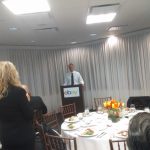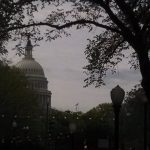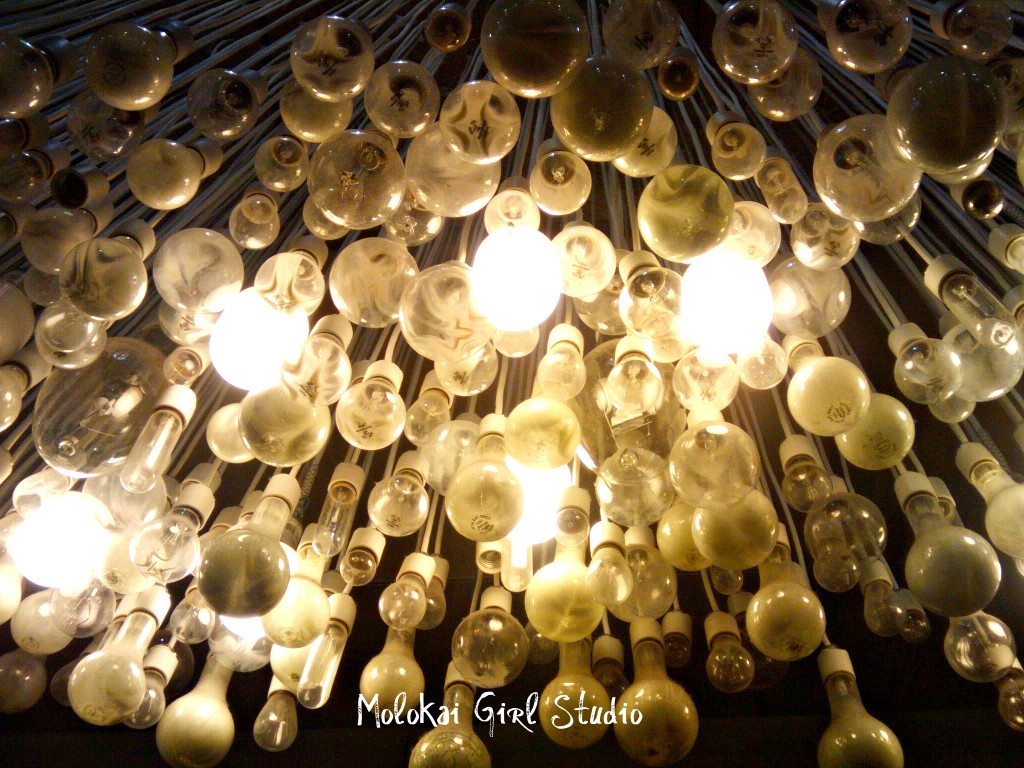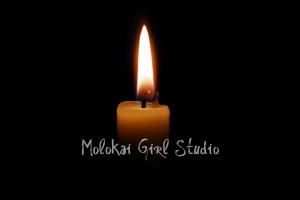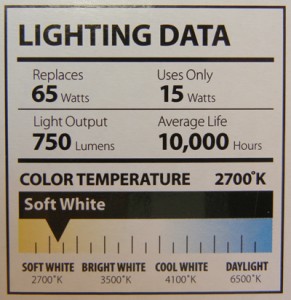Does your T8 or T12 Fluorescent Tube Light fixture have TWO or more Ballasts? Our video shows you how to convert a T8 Fluorescent Tube Light with two or more ballasts to a LED T8 DOUBLE END powered Tube Light using our Total Bulk Lighting products ? If you have electrical wiring knowledge you will be able to perform this task. If you have any doubts we strongly recommend hiring a licensed electrician ?
Fluorescent Retrofits
-
How to convert a TWO Ballast T8 Fluorescent Tube Light to LED T8 DOUBLE END powered Fixture
Tuesday�, June 25th�, 2019Posted in: .
-
Heading to Washington DC - Here's why!
Monday�, April 28th�, 2014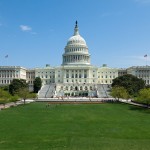 Technology allows smaller businesses like Total Lighting Supply here in Rio Rancho New Mexico to reach customers across the nation and the globe and expand their business. Changes to online trading can be a game-changer for their long-term success and sustainability.
Technology allows smaller businesses like Total Lighting Supply here in Rio Rancho New Mexico to reach customers across the nation and the globe and expand their business. Changes to online trading can be a game-changer for their long-term success and sustainability.That’s why we are sending one of our own to Washington D.C. on April 29 and 30 2014 for eBay Inc.’s 9th annual U.S. of eBay Advocacy Day. Our time will be spent encouraging lawmakers to support policies that promote small business growth and success. During the trip to Washington we will share with lawmakers the proposed way Internet sales tax legislation will create a huge tax burden for small business owners selling their products online.
The Marketplace Fairness Act would force Total Lighting Supply and thousands of businesses like ours to collect sales tax from our customers for any state to which we sell, which would mean collecting and remitting taxes for up to 9,600 tax jurisdictions nationwide. That's a lot of paper work! Total Lighting Supply and eBay are advocating for greater equity for small online businesses like ours so that we can continue to grow and contribute to our local New Mexico economy.
Additionally we will be discussing the importance of eliminating trading barriers for small and medium-sized enterprises.
Thank you for reading :)
Have a blessed day!
Total Lighting SupplyPosted in:
Tags: DC, Government, Internet, Taxes
-
The "KISS" Method: Keep It Super Simple
Friday�, January 27th�, 2012Many of you are familiar with the "KISS" method? Keep it super simple (well, there is another version out there-the "keep it simple s-----", but we won't use that language here!) Sometimes simple is the best. One of our clients that does large trade shows in the fashion industry came to us with a dilemma. They had three days to light a huge color banner of one of their models for a trade show in Austin, Texas. The trade show facility vendor wanted to rent them $1800 in LED lighting for the three days they were there- which was way outside of their budget. They needed the banner to stand out and be seen, but the quoted rental fee definitely put it out of reach. The owner of the fashion company called and talked with our lead lighting designer, Mark Scott. Mark has been in the lighting industry for 30 years and has wonderful and creative solutions to just about any lighting dilemma. His simple solution got the banner to stand out with even, bright light all for under $300 total. The client also got to keep the lighting fixtures for their next upcoming show too. Sometimes a simple solution is the way to go. So, what was the simple solution? They used two 500watt wide flood Par64 fixtures with bulbs, and one PAR64 flood to highlight the banner on the top left so it would be slightly brighter there.
Easy solution, and boy did that banner stand out-it was easily seen from the other side of the convention center. No matter what your project is, from kitchens to landscape lighting, good lighting can make all the difference in the world. The staff at Total Lighting Supply are not about just selling part numbers on box, they are about getting you the light you need to make your project sparkle.
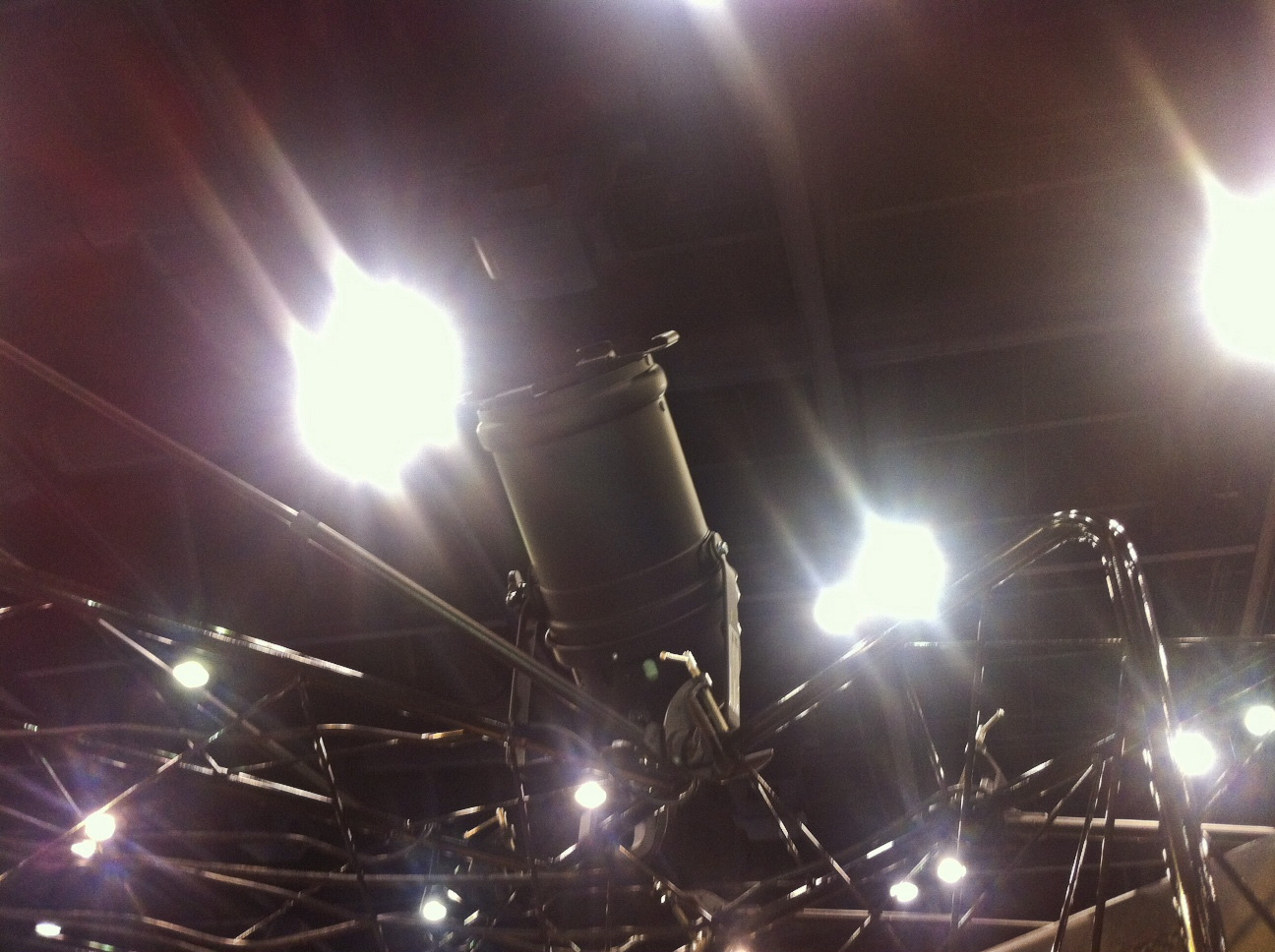
Looking up at the par lights above the trade show booth
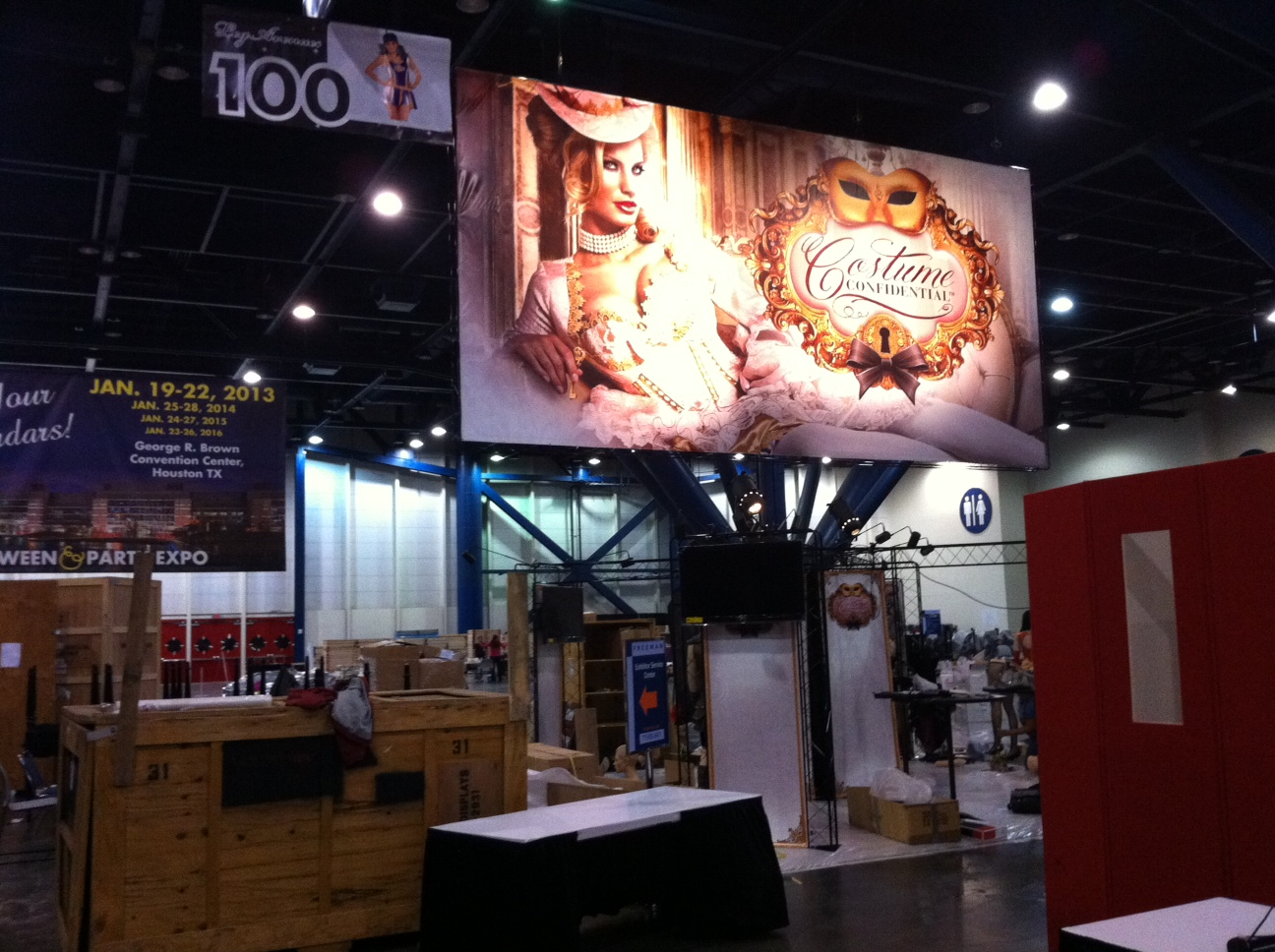
Full view of the poster (well lit, we might add!)
We here at Total Lighting Supply are on a mission to demystify lighting aspects one bulb, one fixture at a time.
Want to be demystified even more? Go to our You Tube Channel and check out the informational videos that we've made for you.
Posted in:
-
LED, Incandescents, CFL's, Oh, No!! (Or, Watt's Up??)
Tuesday�, September 20th�, 2011(Grab your cuppa coffee or tea and sit down with it as you dig in to this article...)
So, 'watt's' up with the new light bulb law coming into effect in January 2012 (which is named the Energy Independence and Security Act of 2007)? Will incandescent light bulbs be outlawed? Will we be 'forced' to buy CFL's (amidst the mercury contamination hubbub) or LED bulbs? Incandescent bulbs will begin the process of being phased out just by virtue of the new efficiency standards that will go into effect. These new standards require that a general purpose bulb that produces 310-2600 lumens of light be 30% more energy efficient. That means that come January 2012, a 100 watt incandescent bulb will not meet these new standards.
"What do mean lumens?" you say. "What about watts?" Oh, yes. This gets complicated in the sense that you have to reset your way of thinking about light bulbs (if you haven't already). Contrary to what (no pun intended here) you thought about watts, lumens refer to the measurement of the intensity of light (brightness or light output, if you will), not watts. For some reason, we have been taught to equate watts in regards to how bright light a bulb is. Watts were never a measurement of light output. Watts refer to energy consumption. In regards to a 100 watt light bulb turned on for one hour, the energy used is 100 watt-hours. A 40 watt bulb would use the same amount of energy in a span of about 2 1/2 hours. So, how bright is a 100 watt incandescent bulb? About 1,700 lumens. Pretty darned bright. We'll shed more light on lumens in just a bit (oh, sorry, another bad pun).
More on watts. Once again, wattage is a measurement of electricity consumption only. It is not a measurement of light output or effectiveness. Yes, I know I already said that, but it bears repeating since we all have to undo a lifetime of thinking of watts as the brightness of a bulb. A higher wattage does not mean a brighter light. It is good to note that when you apply power to a (bulb) you produce two things: light and heat. The heat, of course, is an unwanted byproduct. But, how come we are in the habit of thinking of higher wattage as being the brighter bulb? That's because with incandescent bulbs, in order for it to achieve more brightness, it requires more energy to produce that. Which is not the case for LED and fluorescent lamps. They can actually produce a brighter light source with less wattage. Is this starting to make sense now?
Lumens, Color Rendering (aka CRI), Color Temperature, Candle Power are all measurements made for the visible light output as it relates to the human eye. These are metrics specifically related to how the human eye sees light. Why are there so many categories of light output measurement? I'm not a physicist, but try to think of light as a very complex and multidimensional entity (we're talking about the debate as to whether light is a wave or a particle or both).
Lumens. If you haven't noticed, light bulb packages now contains information in regards to the lumens of that bulb. It is required by law in this country. Europe has similar practices. Remember to think of lumens in regards to actual light output or brightness. Personally, in looking all of this gobbledegook up, in my humble opinion, I think lux would've been a more meaningful measure to put on light bulb packages instead of lumens. But that's all I'll say about lux. Let sleeping dogs lie, as they say.
Color rendering or, CRI-one in the same as CRI stands for color rendering index. In a nutshell, it's the light source's ability to render or reproduce the colors of objects as they would be rendered in natural light. Think of the number for CRI as representing the color accuracy of that light source-the higher the number, the more accurate the color. 100 CRI is the ideal as it represents accurate color rendering. Halogen lights have a CRI of 100 which is why art galleries, museums and high end retail and jewelry stores like to use them. Fluorescent, at best, have a CRI of about 80. Which makes me wonder about those fluorescent lamps advertised as 'full spectrum'. Yet, I cannot, for the life of me, find disclosure on what the lamp's CRI is. Logically, full spectrum would equate to the lamp having a CRI of 100. And, as far as I know, the technology for fluorescent bulbs is not in that range. I'm inclined to think that 'full spectrum' fluorescent lamps have a CRI of about 80. The point I want to make here is that a fluorescent bulb being touted as 'full spectrum' does not render color as accurately as a bulb that has been rated with a CRI of 100. If you want/need a light source that gives you accurate color rendering, it would be best not to rely solely on a fluorescent bulb labeled as 'full spectrum'.
If you are a colorphile or a colorist, insist on knowing what the CRI is for your light source. As far as the term, 'full spectrum' goes, it is just another marketing term that really is meaningless unless the CRI is also provided.
Color temperature. Not to be confused or not to be used interchangeably with color rendering! I like to think of color temperature as the color quality of the light source. For example, the color quality of sunlight at dusk is so very different from the color quality of sunlight at mid day. That is what color temperature is. It is expressed in kelvin degrees (K). A candle flame, sunrise and sunset has a color temperature of about 1,850K, whereas, the noon day sun is about 5,000-6,000K, and an overcast day is about 6,500K. Incandescent bulbs are about 2,700-3,300K. Which is what most of us grew up with in our households and will also explain why, when replacing with bulbs that are closer to the noon day sun, the light in the rooms feels 'off'. Because you simply are not used to being around that color temperature in your home.
As far as candle power goes, I offer no discussion here (only a pretty picture!) since that form of light measurement is obsolete. I only mentioned it since it is one of the many ways light can be described. You can always click on the link provided if you've become insatiable in regards to lighting terms.
How do we know which bulb gives us the most bang for our buck? Nearly everyone these days are watching what they spend carefully. Comparative shopping is a must. I don't know about you, but I've spent quite a bit of time in the light bulb section of a store reading the package labels, trying to figure which bulb I needed for my studio space!
Start off with defining the lighting needs for the area being lit. For my studio space, I need a very bright light source so, pop quiz folks, what will I look for on the package to tell me that? Yes, you're right: lumens. Not watts. Since my studio space only allows for the screw in type of bulb, the compact fluorescent (aka CFL) is my first choice because it is energy efficient and they do come in acceptable lumen offerings (in this case, I chose a 25 watt 1200 lumen bulb). The trade off is that, now my artificial light source does not have accurate color rendering. That is my compromise of choice since I now have an energy efficient and bright light source. I do get a nice amount of daylight through a window, so I am not totally short changed on having color rendered accurately. In fact, throughout most of our home, we use CFL's because they are readily available at affordable prices and last a long time. Believe it not, your CFLs will last longer if you just leave it on. It is not meant to be turned on and off as we've been in the habit of doing with the incandescent light bulbs. Nor do you save energy by turning them off and on (the CFLs). There was a fun demonstration of this on the TV series, "Mythbusters".
Light bulb manufacturers are not required by law to include information on color temperature or color rendering on their packaging. They are required to include lumens and wattage. But, wouldn't you also want to know what the color temperature is? Instead, you get terms like, 'soft white' or 'cool white' or other variations. Oh, and GE has their own proprietary definition and created their 'Reveal' light bulbs. Anyway, now that YOU know a little bit more about color temperature, you can make your choices with more confidence.
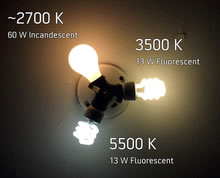
(image from Wikipedia)
As a consumer, I think light bulb manufacturers are underestimating their audience. As consumers, we should demand to know what the CRI and the color temperature of a bulb is. Why not? And then they can rid themselves of the 'dumbing down' on their packages that say, "25w=75w". Please, just tell me the lumens, CRI and wattage and I'll be good to go. Although in all fairness, some manufacturers do indeed include more information such as the label on this package:
And, isn't this kind of labeling much more preferred than the old school stuff? With information like this on a package, I don't feel like I'm making a decision in the dark (sorry) and I know that the light bulb will fit my needs in the space I intend it for. Now you are armed with enough information to make those choices between CFLs and LEDs. And, even incandescents if you feel so inclined.
You know, as the saying goes, this is just the tip of the iceberg-there is still plenty more to discuss by way of LED, incandescents and CFLs, so look for more on this topic in future postings! By now, you've finished that cuppa coffee or tea you sat down with and it's time to move on...
I'd love to hear your comments and any other questions (and I will entertain lighting article topics). Send me your 'Q's" and I'll send you those 'A's"! Just leave a comment here on this blog.
Posted in:
Tags: cfls, compact fluorescents, comparison, incandescents, led
-
Updating our Blog
Thursday�, February 10th�, 2011We are currently updating our blog! It should be populated with posts and information very soon :)
In the meantime please checkout out our main blog here: http://totallightingsupply.com/blog
Posted in: .
5 Item(s)



